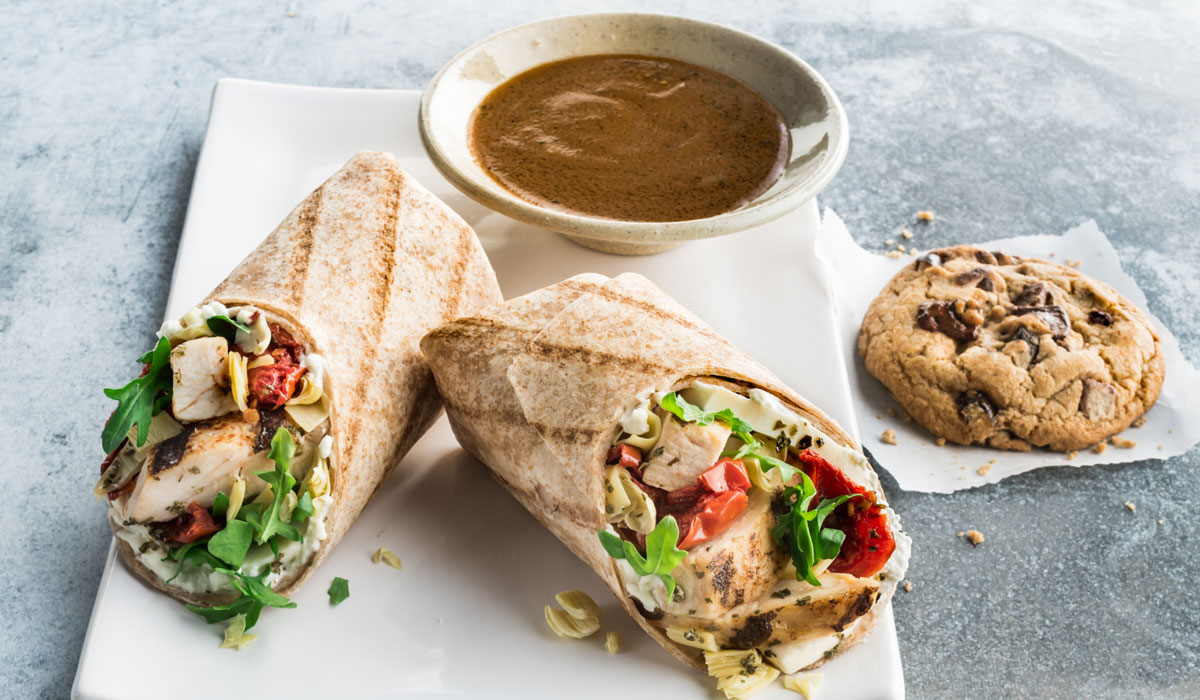Regardless of their destination, passengers on American Airlines flights can now enjoy a taste of the Mediterranean. In December, select items from Zoës Kitchen became available for purchase on most domestic flights longer than three hours. American Airlines passengers had been requesting healthier in-flight food options when a leader in the brand’s food and beverage department realized that one of his favorite restaurants, Zoës Kitchen, could be the perfect way to fulfill those cravings. He approached the Zoës marketing department about a partnership.
A little over a year later, the Texas-based fast casual (which was acquired by fellow Mediterranean concept Cava last August) debuted a limited menu. Offerings included the signature Grüben sandwich with turkey, Manchego cheese, Mediterranean slaw, and feta spread; Hummus Duo & Veggies with classic and basil-pesto flavors; and breakfast sandwich with turkey bacon, egg, tomato, and Calabrian pepper aioli on a waffle brioche bun. More products are slated to roll out over the next two years.
Partnerships between airlines and food and beverage brands are becoming more commonplace, says Joe Leader, CEO of the Airline Passenger Experience Association (apex) and the International Flight Services Association (ifsa). Airlines have long known the value of partnering with established brands—most often through snack food offerings and celebrity chef–branded menus in premium classes. Nearly every major airline partners with household-name chefs, according to an October 2018 Datassential report.
While partnerships between limited-service restaurants and airlines are not commonplace in the U.S., such alliances can offer special benefits.
When an operator like Zoës Kitchen partners with an airline, its food—and by extension its branding—is shared with passengers beyond premium classes, generating a great deal of exposure. Customers in economy classes are looking for comfort and healthy foods in equal measure, according to the Datassential report. Providing a tasty meal at cruising altitude can spark a positive brand association that will stay with travelers even after they disembark.
That’s been the case for Denver-based Boyer’s Coffee, which is the exclusive coffee provider for Frontier Airlines. “Our partnership with Frontier is an amazing brand-awareness opportunity,” say Jason Barrow, who co-owns the brand with his brother, Douglas. “As Frontier customers try our coffee in-flight, they are being introduced to our brand and our smooth flavor.”
In addition to a brick-and-mortar café and a sports arena concession in Denver, Boyer’s coffee is available in grocery stores, restaurants, and offices throughout the intermountain West and Texas. Barrow says the Frontier partnership has increased activity across all these channels.
Zoës Kitchen expects similar brand salience from sharing its offerings with more than 1.7 million annual American Airlines domestic passengers.
“We’re not in every single city in the U.S., so it exposes the brand to the guests who are traveling to cities where they can find a Zoës,” says Casey Shilling, chief marketing officer at Zoës Kitchen. “It also gets them excited for when we do come into their city.”
From the airlines’ perspective, finding familiar brands in-flight can improve customer satisfaction, Leader says. Branded food and beverages boost the perceived dollar value. “Passengers may be hesitant to pay $6 for an in-flight chicken sandwich, but they’ll happily pay that much for Chick-fil-A served in flight,” Leader says.
While bringing beloved brands to the skies offers significant perks, restaurants must navigate various challenges to ensure proper takeoff. There’s also an added pressure to get it right—and fast. Because the potential return on investment is so great for airline partnerships, competition is fierce, Leader says.
He recommends restaurants bring their ideas for in-flight products to an industry expo, such as those put on by IFSA or World Travel Catering & Onboard Services. There, airlines, catering companies, and product brokers can sample various menu items and then shepherd brands through the adaptation process. “It’s a little bit like the ‘Shark Tank’ of the skies,” he says.
Restaurant concepts that want to break into the industry should focus on products that enhance an airline’s points of differentiation, as well as the in-flight experience, Barrow says. Airlines today are focusing on healthy comfort foods, personalization, local flavor and regional tie-ins, and quality, per the Datassential report.
Boyer’s Coffee meets those marks thanks to its uniquely mellow, smooth product—the result of roasting in Denver’s high altitude and low humidity. Frontier passengers get to enjoy distinctly Colorado coffee on a Denver-based airline.
Still, that achievement required more than simply bringing Boyer’s onboard. “Compared to opening a restaurant or selling supermarket shelves, operating in an airline is quantifiably different,” Leader says.
Preparation, flavor profiles, the serving and eating experience, and safety guidelines all differ. Meals, even branded ones, are prepared by third-party caterers at facilities near each airport and then heated in-flight. In-cabin dryness and low humidity can more easily dry out food and reduce one’s ability to taste it by about 30 percent, according to a 2010 study commissioned by German airline Lufthansa.
For its part, Boyer’s created a new product line, invested in new equipment for in-flight brewing, and supplied exclusive beans for Frontier. The team developed easy-to-use equipment that would fit in the allotted space and designed a proprietary brew process to work with the equipment. Boyer’s also found the right beans for special in-flight conditions.
Zoës Kitchen also underwent an extensive recipe adaptation process. The marketing, culinary, and supply teams worked closely with American Airlines’ supply chain. Through taste tests, Zoës collaborated with the lead chefs from the American Airlines catering crew to adapt the recipes, changing ingredients, preparation, and seasonings to maintain quality and flavor at altitude. The team also attended workshops with flight attendants to solicit feedback as to what customers might like.
“We were very diligent and American was very flexible and creative in making sure we were aligned,” Shilling says. Ultimately, that’s what’s necessary to keep a partnership flying smoothly.

